jodebg
Platinum Member
After 2 years of owning my Kubota B7800 with a frozen FEL
control valve (most of the cold season) I decided to correct
the problem.
For those of the TBN members who suggested that there
was water from condensation in the lower housings-they
were correct.
I had no luck finding instructions or photos for this repair
so I decided to post both to help out those with the same issue.
The good news is that we did not encounter any loose ball bearings
or springs. These are nicely machined heavy steel housings with a
removable inner sleeve where the ball bearings are mounted.
I had my neighbor come over to assist and here's what we did.
-Used a hacksaw blade and marked the lowest point
on the bottom of both housings.
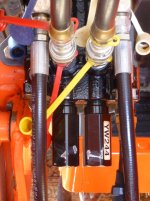
-If memory serves me correctly, we used a 1 5/16th socket to
remove and reinstall the housings. We chose to do them one at a time.
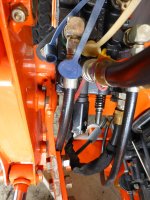
-Note. Both housings are contructed with 2 inner areas where water
gets trapped. Both areas have to be addressed in order for the housing
to fully drain any water that developes due to cold weather condensation.
-Placed the housing into a vise (fully assembled) and cut an angled groove
on the bottom corner (at the hacksaw mark). See photos for location and depth.
(Used an angle grinder with a thin cut-off wheel.)
Inserted a small drill bit into the groove (that we created) and drilled the balance
of the weep hole into the center of the housing area.
*No need to drill a hole in the outer area. The grinding disk will penetrate this area.
Stop grinding when the hole is created in the proper size.
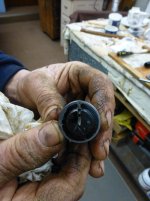
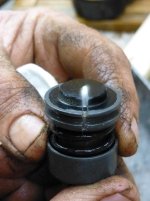
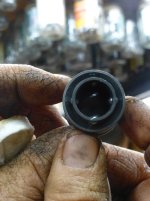
-Removed the small retaining ring at the bottom of the housing.
Inserted a 1/2" wooden dowel into the housing and lightly tapped the
bearing holder out of the bottom of the housing.
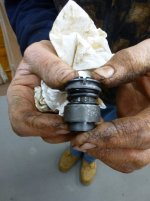
*If you do not remove the bearing holder you may not be able to
remove the water trapped in the outer area. Also, you will not be able to
completely clean the grinding dust and drilling debris.
* We found that the retaining ring groove in the outer housing was not sharp/square and
quite deep enough. Put both housings into a lathe and corrected the groove.
-Thoroughly cleaned both parts, blew out with compressed air and lubed.


*During the reassembly we chose not to install the o-ring on the lower end of the
bearing holder. Reinstalling this o-ring will only trap more water in the future.
If it was not there to begin with, we may not have ever had a water issue.
Technically, if you chose only to remove the o-ring and do nothing else, you
may very well eliminate all water and freezing issues.
-Inserted the bearing holder and compressed it a bit with a c-clamp in order to
reinsert the retaining ring. You will need to use a small block of wood against the housing
treads and an upside down short bolt against the end of the bearing holder in order to
lightly compress the bearing holder before inserting the ring.
-Applied teflon thread lube onto the housing threads and treaded the assembled
housing back into the FEL valve.
-Repeat the above steps for the second housing.
*When completed, I decided to make a foam boot to fit over the ends of both
housings in order to keep dirt, dust and water out of the them. Drilled two
large holes to fit snuggly over the housings. Then, drilled 2 lower weep holes from the
lower side of the boot, up into the base of the larger holes.
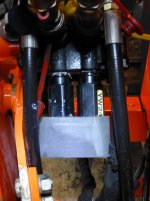
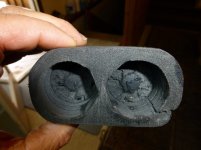
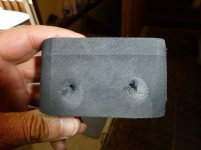
Noticed an improvement in the operation of valve right away. And, with the recent cold weather
no frozen control valve!!
I should also mention that I'm glad I completed this repair. When we went to remove the
outer housing we noticed that both the retaining ring and the bearing holder were being
pushed out of the outer housing. Most likely due to the expansion of the freezing water trapped inside.
I was probably one day away from having the ring and bearing holder drop out and be lost along the trail.
control valve (most of the cold season) I decided to correct
the problem.
For those of the TBN members who suggested that there
was water from condensation in the lower housings-they
were correct.
I had no luck finding instructions or photos for this repair
so I decided to post both to help out those with the same issue.
The good news is that we did not encounter any loose ball bearings
or springs. These are nicely machined heavy steel housings with a
removable inner sleeve where the ball bearings are mounted.
I had my neighbor come over to assist and here's what we did.
-Used a hacksaw blade and marked the lowest point
on the bottom of both housings.

-If memory serves me correctly, we used a 1 5/16th socket to
remove and reinstall the housings. We chose to do them one at a time.

-Note. Both housings are contructed with 2 inner areas where water
gets trapped. Both areas have to be addressed in order for the housing
to fully drain any water that developes due to cold weather condensation.
-Placed the housing into a vise (fully assembled) and cut an angled groove
on the bottom corner (at the hacksaw mark). See photos for location and depth.
(Used an angle grinder with a thin cut-off wheel.)
Inserted a small drill bit into the groove (that we created) and drilled the balance
of the weep hole into the center of the housing area.
*No need to drill a hole in the outer area. The grinding disk will penetrate this area.
Stop grinding when the hole is created in the proper size.



-Removed the small retaining ring at the bottom of the housing.
Inserted a 1/2" wooden dowel into the housing and lightly tapped the
bearing holder out of the bottom of the housing.

*If you do not remove the bearing holder you may not be able to
remove the water trapped in the outer area. Also, you will not be able to
completely clean the grinding dust and drilling debris.
* We found that the retaining ring groove in the outer housing was not sharp/square and
quite deep enough. Put both housings into a lathe and corrected the groove.
-Thoroughly cleaned both parts, blew out with compressed air and lubed.


*During the reassembly we chose not to install the o-ring on the lower end of the
bearing holder. Reinstalling this o-ring will only trap more water in the future.
If it was not there to begin with, we may not have ever had a water issue.
Technically, if you chose only to remove the o-ring and do nothing else, you
may very well eliminate all water and freezing issues.
-Inserted the bearing holder and compressed it a bit with a c-clamp in order to
reinsert the retaining ring. You will need to use a small block of wood against the housing
treads and an upside down short bolt against the end of the bearing holder in order to
lightly compress the bearing holder before inserting the ring.
-Applied teflon thread lube onto the housing threads and treaded the assembled
housing back into the FEL valve.
-Repeat the above steps for the second housing.
*When completed, I decided to make a foam boot to fit over the ends of both
housings in order to keep dirt, dust and water out of the them. Drilled two
large holes to fit snuggly over the housings. Then, drilled 2 lower weep holes from the
lower side of the boot, up into the base of the larger holes.



Noticed an improvement in the operation of valve right away. And, with the recent cold weather
no frozen control valve!!
I should also mention that I'm glad I completed this repair. When we went to remove the
outer housing we noticed that both the retaining ring and the bearing holder were being
pushed out of the outer housing. Most likely due to the expansion of the freezing water trapped inside.
I was probably one day away from having the ring and bearing holder drop out and be lost along the trail.
Last edited:
